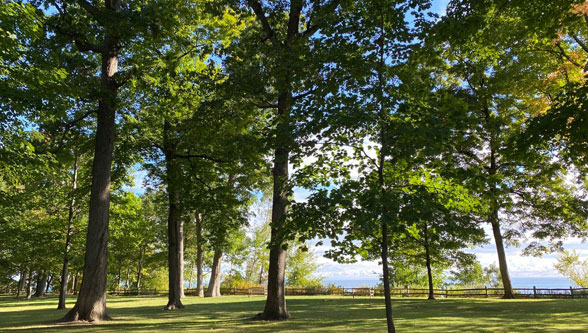For a small town, Lake Bluff has many beautiful open spaces, and one of the best places to enjoy the outdoors is our beloved Sunrise Park.
Thank goodness Sunrise Park even is a park, as its history takes a few surprising and at times shadowy twists and turns. For example, it originally was called Lake Front Park. Another fun fact: the park was a campground and musical venue, with concerts held on a gazebo of all things. Also during the summer resort era, a mineral spa located in the bluff below the park was said to have strong medicinal properties. It dried up, but by the late 1960s those medicinal properties would have come in handy as the park almost became home to the sewage pumping station that’s now odorizing the beach instead.
And for a time, Lake Bluff’s park along the lake almost wasn’t a park at all.
When Lake Bluff Camp Meeting Association founders were platting the summer resort in the 1870s, they designated land along the bluffs to be an open space. It was formally dedicated as Lake Front Park in 1892, “only to be used as a street and park forever.” This supported the Methodist founders’ mission to provide as much green space as possible for summer visitors from Chicago’s emerging middle class.
When Lake Bluff incorporated as a village in 1895, ownership of the park transferred to the Village, and the public space was extended in 1900 to span the area atop the bluff from Ravine Avenue to Center Avenue.
The plot thickened in 1902, when one of the Camp Meeting founders tried to sell off the park, according to newspaper reports. His name was James B. Hobbs, and he was a successful businessman who served on the Chicago Board of Trade, including as president in 1893, and ran for U.S. president in 1884. Hobbs and his wife, Marilla, were generous supporters of charitable enterprises, including donating land and a cottage on Scranton Avenue to the Lake Bluff Orphanage and continuing their support for many years. Hobbs lived by the slogan “Make all you can; save all you can and give all you can,” according to Elmer Vliet’s book, “Lake Bluff: The First 100 Years.”
So how did good-guy Hobbs come to almost cancel our favorite place to watch the waves and clouds float by? In March 1902, prior to a Village election, a group called the Lake Front Protective Association accused Hobbs of trying to plat and sell out the greater part of the lakefront strip east of Sunrise Avenue “including all the land in the bluff and the lake shore” down to the Lake Michigan water line, according to the Chicago Tribune archives.
Hobbs protested, stating he was trying to protect the lakefront from “roisterers” who loitered on the beach on Sundays (when it was closed), as well as from “sand haulers going down to the beach … and getting free sand for Lake Forest and other towns.” Fortunately, Hobbs and his opponents worked things out, and Lake Front Park remained an open space.
Fast forward a few decades: The Lake Bluff Park District was created in 1925, and a few years later it took ownership of local parks. Deed No. 382, filed in 1932 at the Lake County Recorder of Deeds, transfers ownership of “Lake Park” from the Village to the Park District.
The park along the lake survived another near miss in the late 1960s. The North Shore Sanitary District (now cleverly called the North Shore Water Reclamation District) had been pumping sewage through an outflow pipe into Lake Michigan since 1922. In 1968, NSSD passed a referendum to eliminate the discharge of sewage into the lake in Lake Bluff, offering three locations at the end of Prospect Avenue for a new pumping facility, according to “A History of the Lake Bluff Park District” by former general manager Walter Schamber. The locations were on the bluff, in the bluff, and at the bottom of the bluff. We’re sure you can imagine the stink that raised! Not wanting a sewage station marring their view of Lake Michigan, not to mention the smell, residents Uri and Marjory Grannis Jr., Yolanda and Cornelia Beall, Genevieve S. Northrop, and Sara S. Roberts, successfully sued to require the NSSD to build the facility on the beach.
So when did the name change to Sunrise Park?
We’re not sure. A postcard in the Museum’s collection from 1956 (shown at the top of this email) has the name Lake Front Park in the lower left corner. Museum board secretary Paul Bergmann, a lifelong Lake Bluff resident, says the park didn’t have much of a name when he was growing up in the 1950s and ‘60s.
“There was a tar & gravel ring road along the bluff,” he says. “I can’t recall any events occurring in the park. It was just vacant land that everyone ignored. We had lots of activities at the beach. That was the town focus.”
Things started looking up for Lake Front/Sunrise Park in the mid-1970s, when the asphalt road was removed and the park became whole again. Was the name changed to Sunrise Park then? Or was it never formally named? After all, it is literally a lakefront park on a street called Sunrise Avenue.
Either way, we hope you enjoy the fall show, wherever you are … and especially if you are in Lake Bluff!
